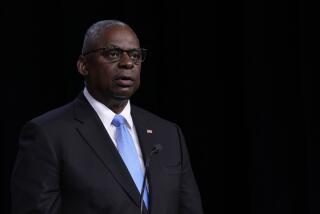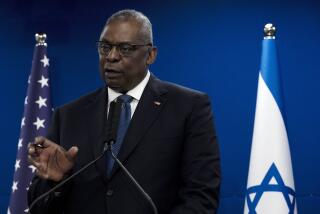Marines to Hold Mock Raid on Saudi Beaches : Military: The drill will occur less than 30 miles from Kuwait. Officials deny it is intended to provoke Iraqis.
- Share via
WASHINGTON — U.S. Marines will storm Saudi Arabian beaches less than 30 miles south of the Kuwaiti border in a mock amphibious landing scheduled for this weekend, Pentagon officials said Tuesday.
The exercise, which will simulate a tactic likely to be used in any actual U.S. military offensive, will be the first conducted in Saudi Arabia since Iraq’s Aug. 2 invasion of Kuwait. Pentagon officials said it is intended to intensify pressure on Iraqi leader Saddam Hussein to withdraw.
At the same time, the exercise represents one of the most provocative gestures that the U.S. military has taken toward Iraqi troops dug into largely defensive positions just inside Kuwait.
Pentagon sources said that the exercise is expected to involve as many as 30 U.S. warplanes and 2,500 Marines who have been afloat on 13 amphibious ships in the Persian Gulf for more than two months.
The Pentagon’s acknowledgment of the pending military maneuver came as Bush Administration officials tried to quell growing concern on Capitol Hill that the United States is pressing to initiate hostilities soon against Iraq. The plan sparked significant controversy among lawmakers briefed Tuesday by Defense Secretary Dick Cheney and Gen. Colin L. Powell, chairman of the Joint Chiefs of Staff.
The White House, in remarks that were seen as confirming the apparent rush toward war, has warned that Congress must give the President latitude to respond to sudden threats by Iraq. “There are always those unforeseen kinds of provocations that might result in having to move first,” White House Press Secretary Marlin Fitzwater said Monday.
But Pentagon spokesman Pete Williams, in confirming reports of the planned amphibious landing exercise, denied that the Marine maneuvers are designed to provoke a reaction from Iraqi troops that could be used to justify a U.S. military response.
“I don’t know how in the world you could describe these as provocative,” Williams said. Calling the situation in the Persian Gulf “very fluid,” he added: “We have to be able to exercise our forces throughout the region. Exercising them in sovereign Saudi territory to make them familiar with the entire area in which they could potentially be involved is a sensible thing to do with the units.”
Sources at the Pentagon, however, acknowledged that this weekend’s activity, which follows two previous exercises staged on the beaches of Oman, is designed to underscore U.S. military readiness for operations against Iraqi troops.
“It’s close enough to get their attention, that’s for sure,” said one military officer familiar with the plans. “What are they going to think as they watch this on their scopes? It is definitely meant as a show of resolve, but not to create a response.”
In an interview with a French radio station, Powell said that he does not believe that war in the Persian Gulf is imminent, despite the recent announcement that another 200,000 American troops will be dispatched there.
“We hope this show of resolve will convince Mr. Saddam Hussein that he should withdraw his forces,” Powell said. “But at the moment, I don’t think anyone should see that as indicating that a conflict is imminent.”
In choosing a site about 30 miles south of Kuwait’s border with Saudi Arabia, commanders in the region rejected proposals to conduct the exercise even closer to Iraqi troop encampments.
“It’s one thing to mount a demonstration of resolve,” a senior Pentagon official said. “But it’s another thing to expose yourself unnecessarily to someone with a hair trigger.”
This weekend’s mock landing will include aerial support from Marine transport helicopters, attack choppers and Harrier fighter-bombers. Williams said that such exercises are the only way to maintain and sharpen the skills of Marines deployed in ships awaiting further orders offshore.
The Pentagon also announced Tuesday that it has authorized the call-up of additional Navy reservists and will take similar steps for other services in the wake of the President’s decision to send more troops to the gulf.
Williams said that Deputy Secretary of Defense Donald Atwood acted last Friday to raise the ceiling on calling up Navy reservists from 6,300 to 10,000. The Navy, which has called 4,616 reservists to active duty, had requested the additional authority and said that some of those to be called up will be members of construction battalions, called Seabees.
Williams said that the total number of reserve and National Guard troops called up now stands at 36,073. But he added that the planned expansion of the U.S. force in the gulf will require the Pentagon’s civilian leaders to extend the other military services’ reserve call-up authority.
The Army has called 24,524 out of a ceiling of 25,000. The Air Force has called 5,278 with a ceiling of 14,500, although a large number of Air Force reservists have volunteered for active duty. The Marine Corps has called 1,144 of 3,000 and the Coast Guard 511 out of 1,250.
More to Read
Sign up for Essential California
The most important California stories and recommendations in your inbox every morning.
You may occasionally receive promotional content from the Los Angeles Times.














